Blogs
Where History and Diver Meet: Wreck Diving in Narvik
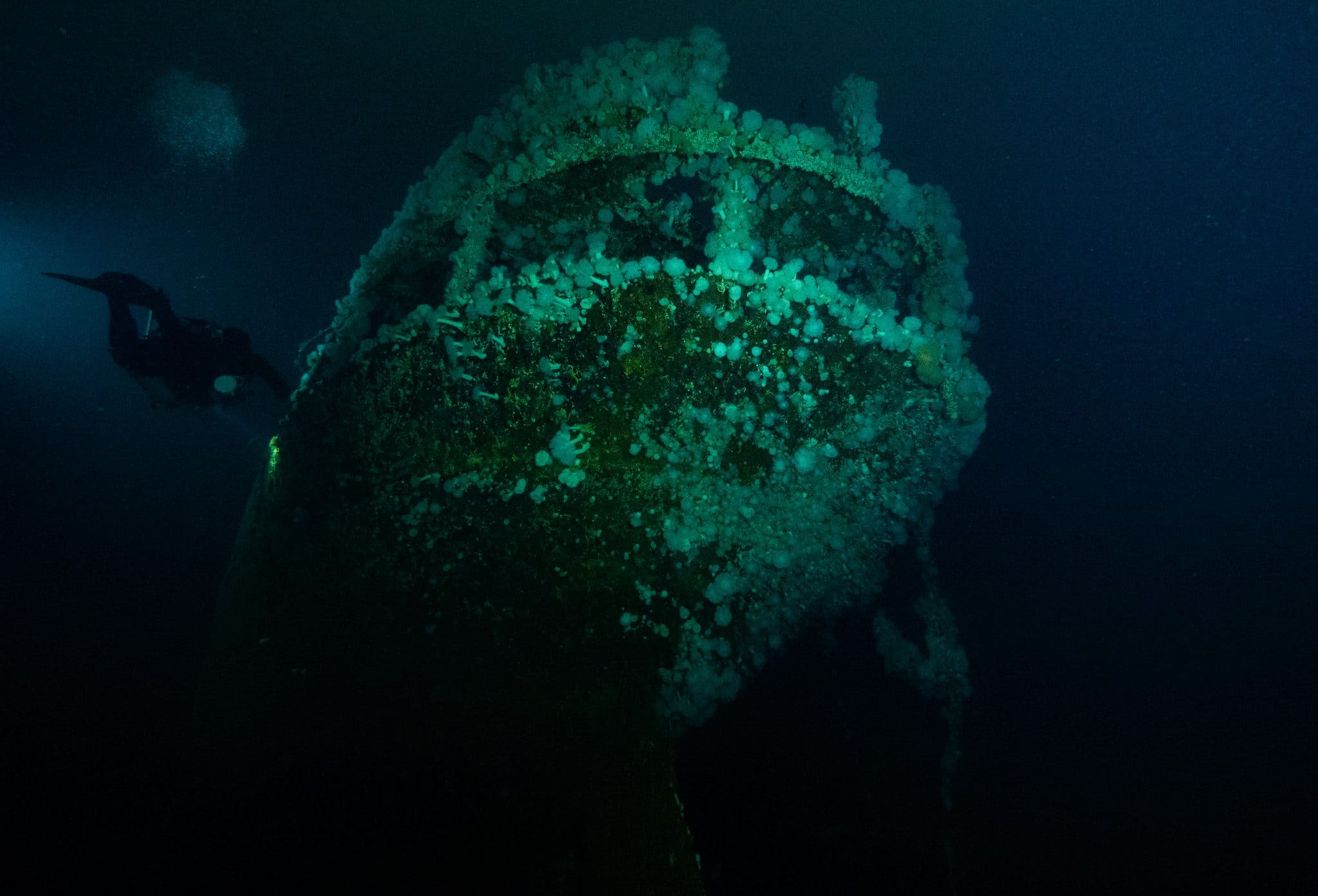
Guest article by Petra Pruden
Cool, clear waters provide exceptional conditions for preserving shipwrecks, and a one-of-a-kind opportunity for divers seeking to explore them. There is one particular location in Norway, near the city and fjord of Ofotfjord, Narvik, that, due to its ideal conditions and historical significance, make it remarkable for diving. Not only are the landscapes spectacular, but during WW2, three significant navy engagements took place there resulting in 16 wrecks accessible to divers today. It’s no surprise that divers such as Australian diver and wreck enthusiast, Edd Stockdale, have been drawn to this location to discover and learn about the wrecks left behind.
Diving with a Story
Located just north of the Arctic Circle in Norway, the coastal city of Narvik offers ice-free access to the North Atlantic. Narvik was a particularly important location in years past as iron ore from Sweden could be shipped there by train, loaded onto ships, and distributed. The city’s strategic foothold caused tension between the British and Norwegian navies and German forces, and they eventually fought to control the transport of iron. From April to June in 1940, three major battles were waged in this fjord resulting in many lives lost and numerous sunken ships. Today, the Narvik fjord is a popular wreck diving site, as the pristine, yet chilly, waters of this protected harbor offer divers and tourists alike an unforgettable, historical experience.
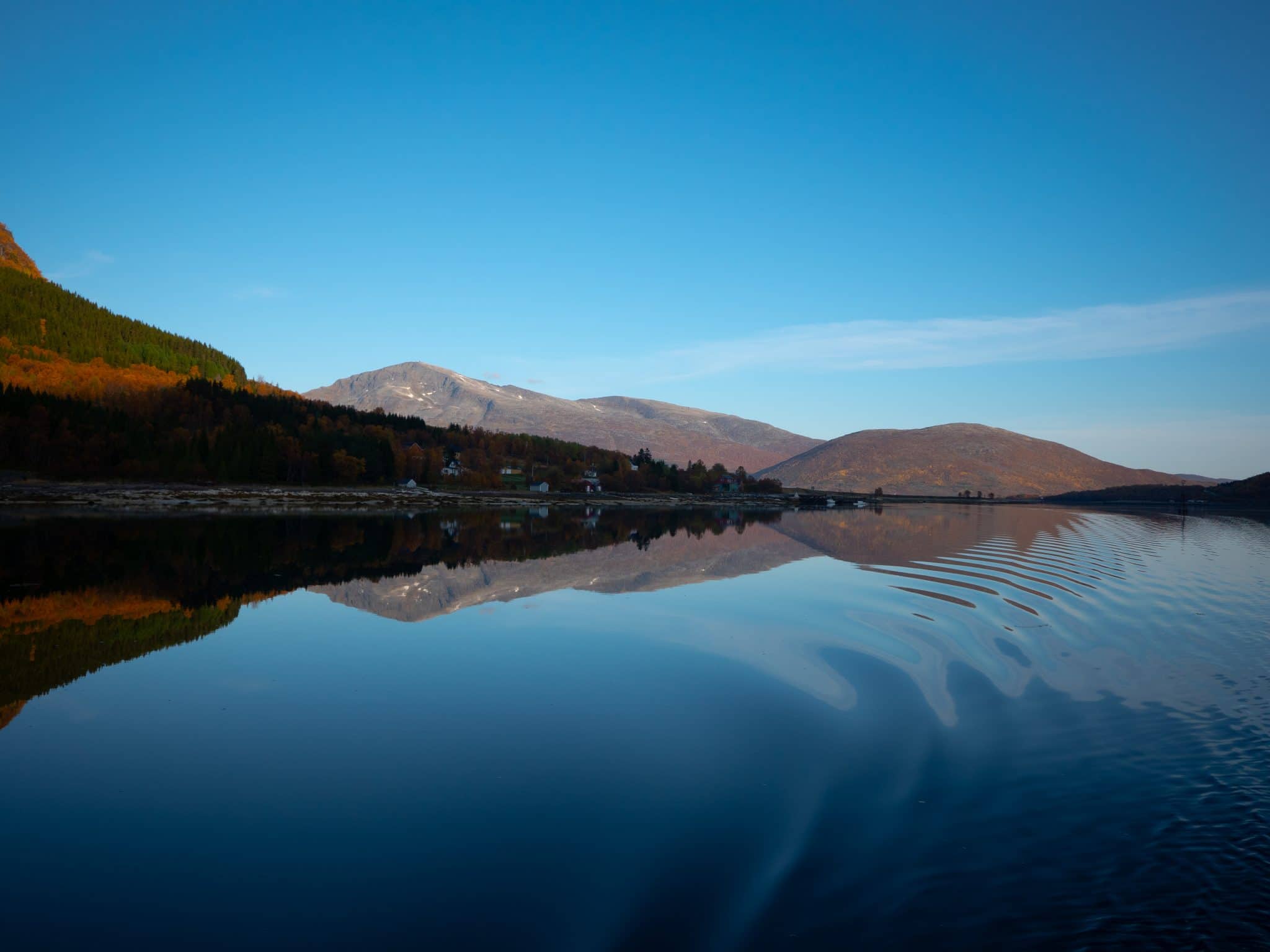
Edd Stockdale and His Trip to Narvik
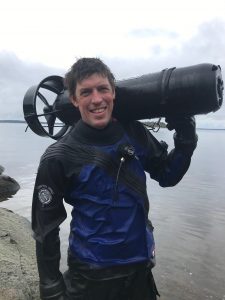
Edd Stockdale
One such diver who found himself drawn to the history and wonder of Narvik is Edd Stockdale. Edd first picked up diving as a boy, and his passion for the sport quickly turned into a lifelong career. Originally from Australia, Edd followed his love for cold dives and made Sweden his new home. With over 5,500 dives in his logbook, 20 years-worth of diving experience, and his name gracing the cover of several prominent training course manuals (RAID instruction manuals), Edd is the kind of guy to take you on a true adventure. Given that his home in Sweden is (relatively) close to Narvik, this last year he made the drive to the famous location to discover some of the wrecks for himself.
Once Edd reached the harbor, he was joined by a group of Swedish and Finnish wreck divers, explorers, and historians aboard an old Swedish minesweeper, the Galten. “Our days generally consisted of getting up at a reasonable time, having breakfast, and getting our rebreathers ready for the day’s diving,” described Edd, then further adding, “We dropped a shot-line at each wreck we visited, then staggered the entry teams to allow time for decompression. Each dive took between 2-3 hours, and after we were finished and the shot-lines recovered, we got to enjoy a relaxing evening on the ship, which, in true Norwegian form, even included a sauna.”
The Erich Giese
With as many as 16 wrecks in the vicinity of Narvik, it’s difficult for divers, Edd included, to choose a favorite dive. “On past dives, I enjoyed visiting the Erich Giese, a German Z class destroyer that sits in about 65 meters of water,” recalled Edd. Back in the late 1930s, the Erich Giese was part of Nazi Germany’s Kriegsmarine, or, in other words, the German navy. During the early stages of the Norwegian Campaign, this ship engaged in naval combat with two British destroyers as it tried to make its way out of Narvik Harbor. Although it was temporarily successful in defending its escape, narrowly dodging five torpedoes fired by the British, it was eventually reduced to a burning wreck after enduring as many as 20 turret shots.
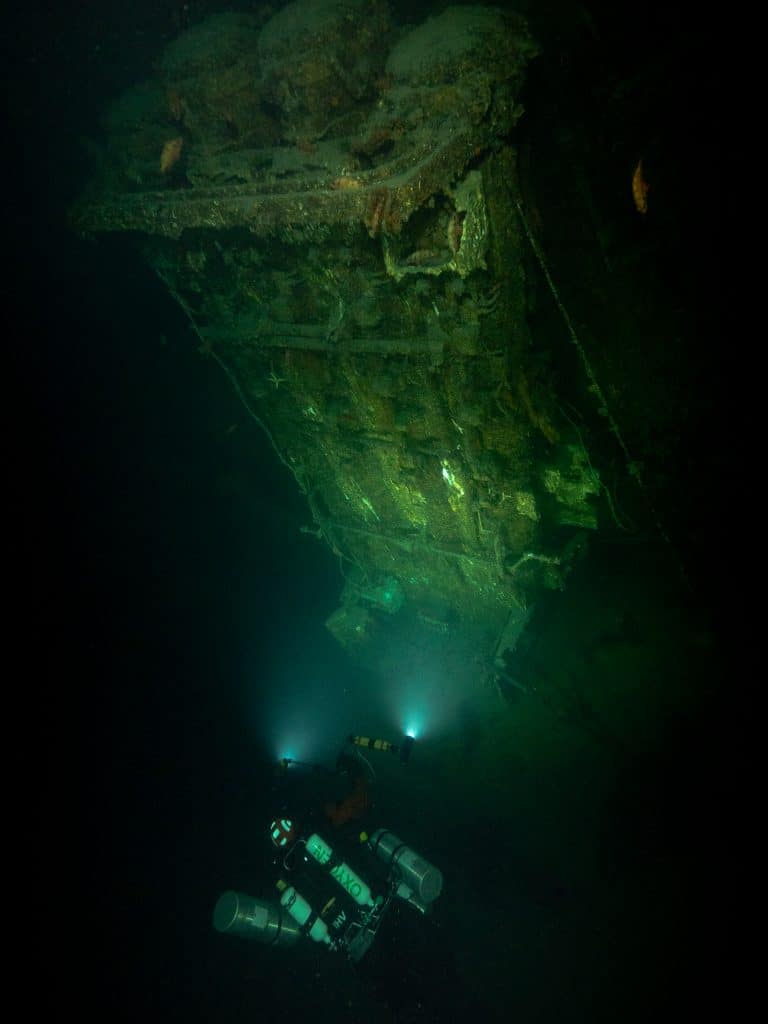
Aft Torpedo launcher Erich Gise
The Landego
Apart from diving the Erich Giese for the first time, Edd was also able to explore the D/S Landego, which he described as “stunning to see up close, with many of its details remaining intact, if not for the Arctic marine life that has taken to living onboard.” The Landego also shares a rather intriguing war story. According to Norwegian reports, the ship was requisitioned by the Germans and used to lay cable for military communication purposes. However, as it turned out, the exact spot chosen by the Germans for laying the cable was an active minefield. The Landego struck a mine, exploded on impact, and cost the lives of 9 men onboard. Today it sits approximately 300 meters offshore and provides divers with an extraordinary diving experience.
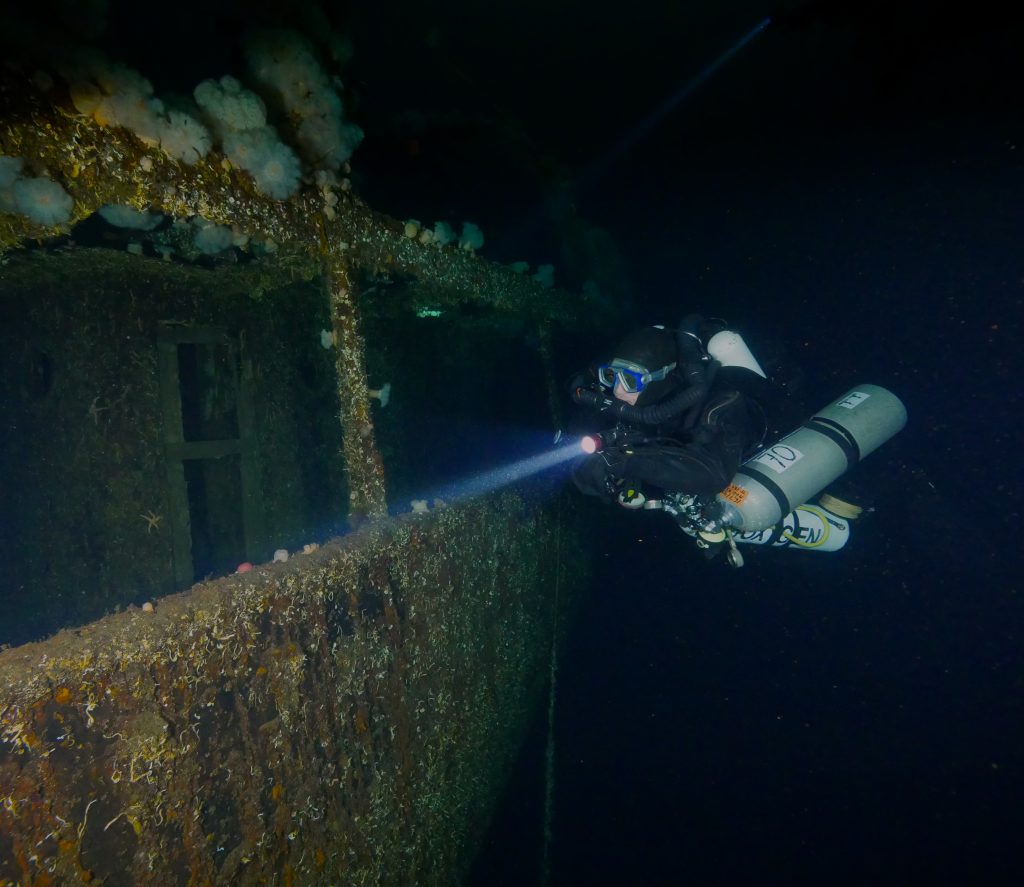
Diver on port side of Landego
If Wrecks Could Speak
It seems the more you look into the history of each wreck in this area, the closer you come to understanding the difficult circumstances many of these men were forced to endure. For Edd, learning the stories of the wrecks he dives has become standard practice. “As with every dive we go on, we are briefed beforehand on the history of the site, which we can then use to compare with the photos and videos we later capture on our dive. This provides our trip with extra meaning, especially in a place like Narvik, where such a large naval conflict was carried out in a relatively small body of water.” It’s interesting, yet also harrowing, to think that a German invasion from 1940 ultimately turned into what is today seen as one of Europe’s top wreck diving destinations.
After learning about the ships’ backstories, Edd and his team are eager to get in the water and start exploring. Edd dons his Liberty sidemount rebreather which allows him to better pass through some of the smaller doorways and access points of the wrecks. Once in the water, Edd and his team take their time searching the sunken ships, combing over details such as torpedoes and bullet holes, and comparing what they found under the water with what they had learned during the briefing. They also take care to document everything they see with their underwater cameras, and even go so far to share videos of their experience on YouTube. This is the perfect way for Edd to relive some of the moments of these dives, while also providing newcomers with some insight on what to expect before getting in the water.
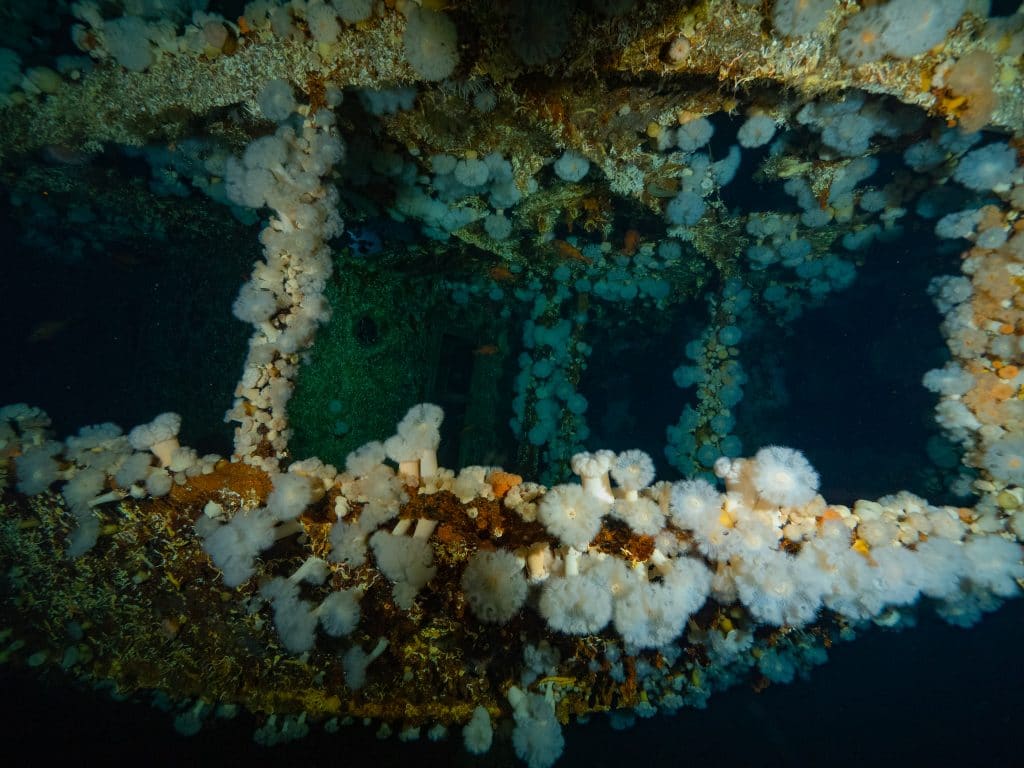
Ladego Stern Deck
Plans for the Future
When asked if he would recommend Narvik to fellow divers, Edd replied with enthusiasm, “Basically, if you like brilliant wreck diving, clear water, stunning scenery, and impressive, historically-relevant dive sites, Narvik is the place for you.” He then went on to add, speaking as a professional diver, that one of Narvik’s greatest advantages is that many of the wrecks sit in 10-30 meters of water, meaning even shallow range divers can discover these remarkable WW2 shipwrecks.
Plus, with so many wrecks located in one fjord, Narvik is the ideal location for divers to make return visits. Edd is already planning his next trip to the area, adding, “Narvik is one of the greatest places to go and teach wreck penetration courses. And, given that wreck photography is a hobby of mine, there’s no better place for me to keep visiting and get all my amazing shots in one place.”
A Destination to Dive
For most divers, just the fact that 16 accessible shipwrecks can be found within such close proximity of one another is reason enough to visit this unique spot. Plus, with the striking landscapes of the Norwegian fjords, the rich history to be discovered, and need we mention the saunas, it’s easy to see why Narvik could command the top slot on divers’ bucket lists. If you’re ready to see for yourself what Edd Stockdale and his team have been so enchanted by, pack your gear and head north to this unforgettable place. Perhaps you could even join Edd there!
Edd Stockdale is an Ambassador for Divesoft. Find out more about the CCR Liberty at www.divesoft.com/en/products/ccr-liberty
News
Filming 360 in The Bahamas

In December 2024, the Shark Trust had a very special opportunity to film sharks and rays in The Bahamas. Frogfish Photography are the Bahamas Dive Ambassadors for the UK. And Caroline, Deputy Editor at Scubaverse, is the Marketing Manager at the Shark Trust. So, when the need arose to film footage of several species of shark and ray for a new Shark Trust project, The Bahamas seemed the perfect fit. A huge thank you is needed here to the Bahamas Ministry of Tourism. As they stepped in to fully support the trip both financially and practically. Ensuring that the filming expedition ran smoothly, and that we got as much time as possible in the water with sharks and rays, during the 10 day, 3 island trip.

The Bahamas is famous for its sharks and rays. Divers flock there to experience getting up close to a range of species. Our itinerary saw us visit Nassau, Bimini and Grand Bahama. It packed in as many in-water experiences as possible and had us dive, snorkel, and even take a submarine to experience them in a variety of different habitats and to capture them on film. We saw 148 sharks and rays from 8 different species (all of which have been logged on the Shark Trust Shark Log!).

But why were we there? The expedition was designed to fulfil the needs of two new projects being launched by the Shark Trust in 2025. The filming done underwater on this trip was the start of creating OneOcean360: A Shark Story. A new 360 immersive experience designed primarily for immersive domes and planetariums. The film will be the nearest experience to getting in the water with sharks and rays without getting wet! It will bring the world of sharks to an audience that may never get the chance to experience it first-hand. A Shark Story aims to deepen people’s understanding of sharks, uncovering and illustrating why they are so wonderful as well as being vital to marine ecosystems.
The film is being made in collaboration with Real Immersive. Also based in Plymouth, they have an immersive dome and are providing the technical expertise behind creating this unique experience. Reviewing the footage in the dome has been an invaluable part of the process. Both inspiring the team and allow us to refine the filming techniques to suit this immersive theatre.

You might imagine that we are using expensive cameras and even more expensive housings. But this is not the case. The entire project is being filmed using Insta360 X4 cameras. With only a few simple additions to the standard dive setup. The INON weight plate allowed us to attach this camera to a dive weight, set it down on sand or wreck, and then swim away and let the sharks be the stars. And the results are very exciting. The film will be ready this autumn. It will be accompanied by an educational pack for teachers to take away after school trips to see the film. Encouraging all those that see it to continue learning about these incredible animals.
You can support the creation of OneOcean360: A Shark Story by heading to the crowdfunder page and donating or selecting a reward.
https://www.crowdfunder.co.uk/p/a-shark-story
Read about the shark and ray dives we did on Nassau, Bimini and Grand Bahama in our next blog post coming soon on Scubaverse.
Blogs
PADI Global Membership Contributes to Study That Indicates Revival of MPAs Would Bolster Billions for the Industry

Scientists, including those from National Geographic Pristine Seas, find scuba divers are willing to pay more to seek adventure in Marine Protected Areas, estimating an additional USD 2.7 billion spent per annum.
11 February 2025 – PADI®, the world’s largest scuba diving organisation, has been working with National Geographic Pristine Seas for the last three years to help identify the positive effects of protecting scuba diving sites around the world – which was recently published in new peer-reviewed research.

PADI’s global membership of 6,600 PADI Dive Centres and Resorts in over 180 countries helped National Geographic Pristine Seas assemble a database that estimated the number of scuba dives annually, the extent to which protection would increase biomass and biodiversity in an area, and a scuba diver’s willingness to pay access fees to dive in Marine Protected Areas (MPAs).

As a result, the study found that more fully protected dive sites would generate an estimated USD 2.7 billion in additional income globally for the scuba diving industry, most of which would come from access fees paid by divers directly to local communities. This additional protection would also help regenerate marine ecosystems and a new long-term income source for these coastal economies.

“Bottom line, ocean protection benefits marine life, coastal communities and businesses,” remarked Enric Sala, founder of National Geographic Pristine Seas. “Protecting diving sites from fishing and other damaging activities can generate new streams of income and benefit more people. It’s increasingly clear that efforts to protect 30% of the ocean by 2030 are even more beneficial than we thought.”

These research findings directly align with the goals of PADI’s Blueprint For Ocean Action– in which safeguarding recreational dive hotspots around the globe would deliver a host of benefits to tourists, local communities, and marine life. In 2022 PADI Iaunched an ambitious new initiative to establish the world’s largest network of conservation sites aimed at protecting ocean habitats and species threatened with extinction. Supported by Blancpain, founding partner of PADI’s MPA Program, the Adopt The Blue™ program activates a global network of dive sites across the planet to establish more Marine Protected Areas to regenerate local economies and coastlines.

“By PADI joining forces with like-minded global partners such as National Geographic Pristine Seas, we will exponentially increase our positive impact for saving the ocean,” said Dr. Drew Richardson, President & CEO of PADI. “With more marine protected areas, we can reinvigorate the diver experience and regenerate hope for the ocean; and with that comes more people who are inspired to explore the ocean and become Torchbearers to further advocate for safeguarding its future.”

Since 2008, National Geographic Pristine Seas has helped establish 29 of the largest MPAs in the world, covering a total area of 6.9 million square kilometers – more than twice the size of India. Their latest peer-reviewed research joins their resume of over 300 that have already been published.

“If you protect a marine area, more recreational divers will show up and they’ll pay more for the privilege of seeing sensational underwater life,” said Reniel Cabral, a Senior Lecturer at James Cook University and the study’s lead author. “Communities and businesses are leaving money on the table by overlooking the benefits of marine sanctuaries.”

Other key findings from the most recent study include:
- Some 33 million dives take place in the ocean each year, but only 15% of dive sites are fully protected from fishing and other destructive activities
- More MPAs estimated to increase the number of dives annually by 32% (10 million + more per year)
- Egypt, Thailand, and the US host the most scuba diving annually (est. USD 3 million annually)
- Indonesia, Egypt, and Australia host the most dives within MPA borders annually
- The Philippines, the US, and Indonesia would benefit the most economically from designating sanctuaries in popular diving spots.
- The Global South — host to some 62% of recreational dives — is poised to gain the most.

“The potential for the recreational diver industry to create positive ocean change is unparalleled,” continues Richardson. “As the only global community to have the superhero skills to descend beneath the surface and both connect with and help the marine world directly, there is a massive opportunity to change the way we all seek adventure. As the world’s largest scuba diving organisation, we can play a key part in reaching the global target of 30% protection by 2030 and enrich both ours and the ocean’s livelihood simultaneously.”

To help PADI advocate for the establishment of more MPAs, visit padi.com/aware/AdoptTheBlue
National Geographic Pristine Seas
Pristine Seas works with Indigenous and local communities, governments, and other partners to help protect vital places in the ocean using a unique combination of research, community engagement, policy work, and filmmaking. Since 2008, our program has conducted more than 45 expeditions around the world and helped establish 29 marine reserves, spanning more than 6.9 million square kilometers of ocean. Pristine Seas is part of the global non-profit, the National Geographic Society. Our mission is driven by science and filmmaking — we are fully independent from National Geographic publishing and its media arm.
About PADI
PADI® (Professional Association of Diving Instructors®) is the largest purpose-driven diving organisation with a global network of 6,600 dive centres and resorts, 128,000 professional members, and more than 30 million certified divers to date. Committed to our blue planet, PADI makes the wonder of the underwater world accessible to all, empowering people around the world to experience, explore and take meaningful action, as Ocean TorchbearersTM, to protect the world beneath the surface. For over 50 years, PADI is undeniably The Way the World Learns to Dive®, setting the standard for the highest quality dive training, underwater safety and conservation initiatives while evolving the sport of diving into a passionate lifestyle. For divers by divers, PADI is obsessed with transforming lives and, with its global foundation, PADI AWARETM, creating positive ocean change. Seek Adventure. Save the Ocean.SM www.padi.com
-

 Gear Reviews1 month ago
Gear Reviews1 month agoGear Review: SurfEars 4
-

 News3 months ago
News3 months agoSanta Divers take the Plunge for Charity
-

 Marine Life & Conservation2 months ago
Marine Life & Conservation2 months agoPaul Watson Released as Denmark Blocks Japan’s Extradition Bid
-

 Blogs3 months ago
Blogs3 months agoExperience Malta and Gozo in 2025: A Paradise for Divers and Culture Lovers
-

 Blogs2 months ago
Blogs2 months agoJeff Goodman Launches Underwater Moviemaker Course with NovoScuba
-

 News3 months ago
News3 months agoDive into Adventure: Limited Space Available for January Socorro Liveaboard Trip with Oyster Diving
-

 Blogs3 months ago
Blogs3 months agoThe Benefits of Underwater Photography Workshops
-

 Blogs3 months ago
Blogs3 months agoDiscover Curaçao with the Ultimate Dive Vacation Guide – 2024 DEMA Special Edition













